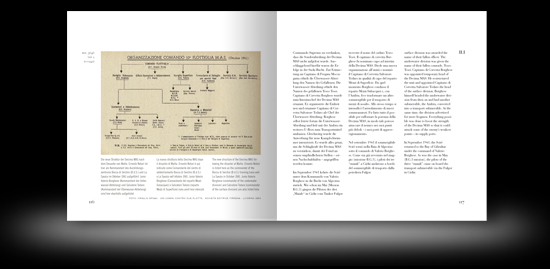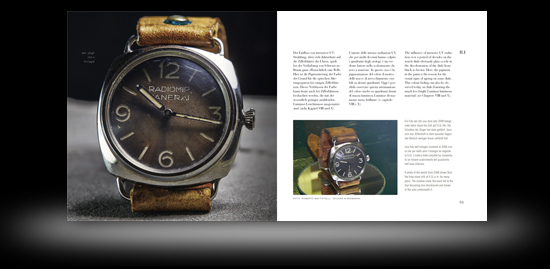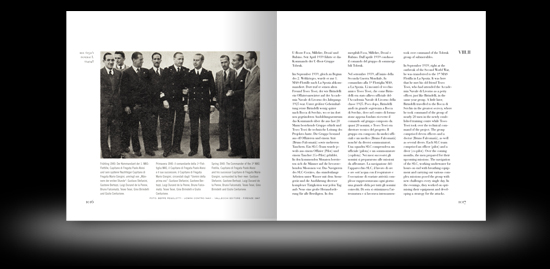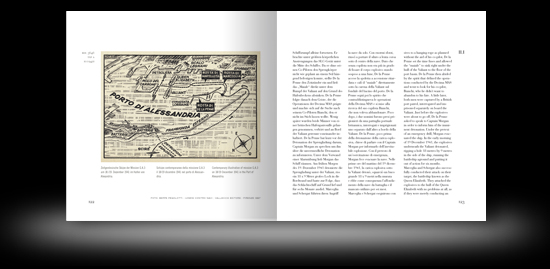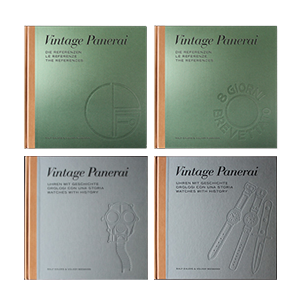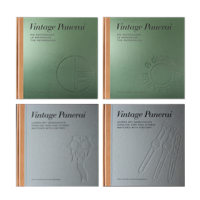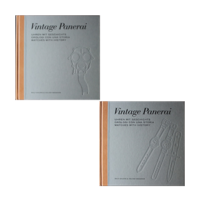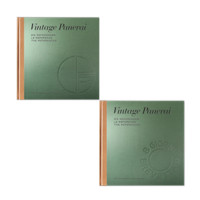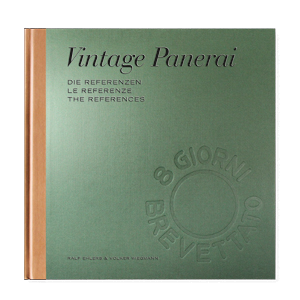Allgemein
Missions and Watches of the Decima MAS
by Volker on May.29, 2024, under Allgemein
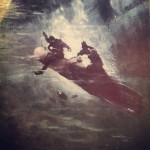 Watches from Guido Panerai & Figlio are deeply connected to the history of the Royal Italian Navy during the Second World War. In our book “The References” we have included an overview of the missions of the “Decima” aside the legendary watches, which were an important part of the units of the underwater (“Mezzi Subacquei” / “Gamma” frogmen and SLC) and surface (“Mezzi di Superficie” / explosive boats) special forces of the Decima MAS (“Mezzi d’Assalto”).
Watches from Guido Panerai & Figlio are deeply connected to the history of the Royal Italian Navy during the Second World War. In our book “The References” we have included an overview of the missions of the “Decima” aside the legendary watches, which were an important part of the units of the underwater (“Mezzi Subacquei” / “Gamma” frogmen and SLC) and surface (“Mezzi di Superficie” / explosive boats) special forces of the Decima MAS (“Mezzi d’Assalto”).
After the disaster at Malta in July 1941 (“Operazione Malta 1”), the Decima MAS was restructured. Capitano di Fregata Ernesto Forza became the new commander of the Decima MAS. The underwater division was given the name of the fallen inventor of the SLC, Teseo Tesei, now commanded by Junio Valerio Borghese. The surface division was given the name of the fallen commander of the Decima, Vittorio Moccagatta, now commanded by Salvatore Todaro (the photo below shows a historical chart of the new structured Mezzi d’Assalto as of October 1941).
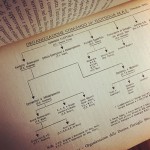 Chapter I and II of the first volume (1930’s-1940’s) carry the history of a new weapon – the SLC slow running torpedo, called “maiale” – and the men who trusted on the watches from Guido Panerai & Figlio during their dangerous missions in deep and darkness of the mediterranean sea. Because of the significance of the fascinating history behind these watches, we have dedicated our book “The References” to the inventors of the SLC, Teseo Tesei and Elios Toschi.
Chapter I and II of the first volume (1930’s-1940’s) carry the history of a new weapon – the SLC slow running torpedo, called “maiale” – and the men who trusted on the watches from Guido Panerai & Figlio during their dangerous missions in deep and darkness of the mediterranean sea. Because of the significance of the fascinating history behind these watches, we have dedicated our book “The References” to the inventors of the SLC, Teseo Tesei and Elios Toschi.
Chapter II of “The References” features some of the rarest Panerai watches owned by famous and high decorated Italian veterans. The first watch of the Reference 3646 / Type A, featured in chapter II.I, belonged to Admiral Ernesto Notari. He was awarded with the Silver Medal for Gallantry at War (M.A.V.M.) for the mission B.G.6 in May 1943.
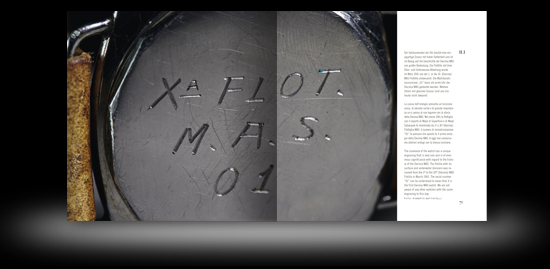
The documentation of the watch (see above page 70-71) and the history of Ernesto Notari, including a summary of the “Mezzi d’Assalto” missions until 8 September 1943 can be read from page 58 to 153 in chapter II.I.
Chapter II.II, about the watches of the Reference 3646 / Type B, features the watch of the legendary “Gamma” frogman Luigio Ferraro. He was awarded with the Gold Medal for Gallantry at War (M.O.V.M.) for his “Stella” missions in the eastern part of the mediterranean sea in 1943.
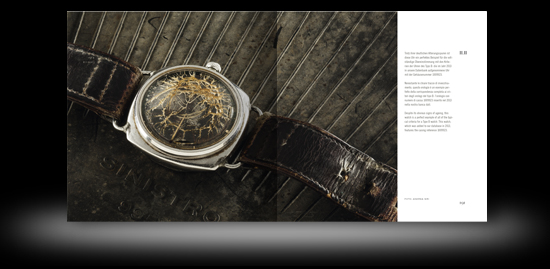
The documentation of the watch (see above page 190-191) and the history of Luigi Ferraro can be read from page 190 to 225 in chapter II.II.
A watch of the Reference 3646 / Type C which belonged to the SLC pilot Licio Visintini is featured in chapter II.III. Visintini took part in several missions against the allied fleet in Gibraltar. After surviving from mission B.G.3 and B.G.4 in 1941, Visintini returned undercover to Gibraltar in June 1942 where he built the core of the “Orsa Maggiore” on board the tanker Olterra – the hidden base for the SLC units of the “Decima” in the bay of Gibraltar. Mission B.G.5 turned into a “mission with no return” for Licio Visintini in December 1942…
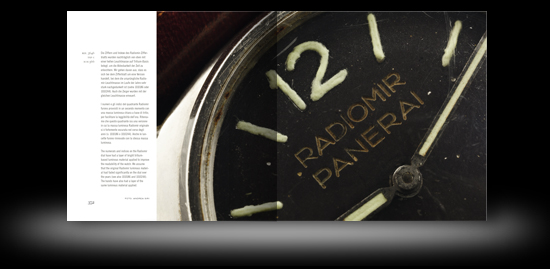
The documentation of the watch (see above page 352-353) and the history of Licio Visintini can be read from page 350 to 397 in chapter II.III.
Information on “The References” 1930’s-1940’s (first volume) can be found here.
Enjoy reading!
[Ralf Ehlers & Volker Wiegmann]
Mezzi d’Assalto
by Volker on Apr.14, 2024, under Allgemein
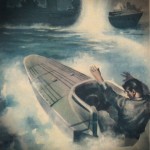 Just a few days before the first success of the MT explosive boats on 26 March 1941 in Souda Bay, the 1st MAS Flotilla changed its name and became the 10th MAS Flotilla – the Decima MAS on 15 March 1941. Capitano di Fregata Vittorio Moccagatta was the new commander and divided the special weaponry – Mezzi d’Assalto – into two divisions:
Just a few days before the first success of the MT explosive boats on 26 March 1941 in Souda Bay, the 1st MAS Flotilla changed its name and became the 10th MAS Flotilla – the Decima MAS on 15 March 1941. Capitano di Fregata Vittorio Moccagatta was the new commander and divided the special weaponry – Mezzi d’Assalto – into two divisions:
The surface division – Mezzi di Superficie – under the command of Capitano di Corvetta Giorgio Giobbe (see photo on page 115, commander Giobbe wearing clearly visible a Panerai watch on his right wrist) had a fleet of various explosive boats (category MT, MTM, MTR, MTS, MTMS, SMA and MTL) for sabotage operations, based in La Spezia.
 The underwater division – Mezzi Subacquei – under the command of Capitano di Corvetta Junio Valerio Borghese operated the diving School in Livorno, the SLC training base at Bocca di Serchio, the transport submersibles (Scirè and Ambra) and the frogmen of the “Gruppo Gamma”.
The underwater division – Mezzi Subacquei – under the command of Capitano di Corvetta Junio Valerio Borghese operated the diving School in Livorno, the SLC training base at Bocca di Serchio, the transport submersibles (Scirè and Ambra) and the frogmen of the “Gruppo Gamma”.
After the desaster at Malta in July 1941 (“Operazione Malta 1”), the Decima MAS was restructured. Capitano di Fregata Ernesto Forza became the new commander of the Decima MAS. The underwater division was given the name of the fallen inventor of the SLC, Teseo Tesei, now commanded by Junio Valerio Borghese. The surface division was given the name of the fallen commander of the Decima, Vittorio Moccagatta, now commanded by Salvatore Todaro. See page 116 with a historical chart of the new structured Mezzi d’Assalto as of October 1941:
Ernesto Notari became commander of the SLC training base at Bocca di Serchio. His Ref. 3646 / Type A “Radiomir Panerai” (with its unique engraved caseback) is documented on page 58 – 91.
Read more about the Mezzi d’Assalto on page 92 – 153 in chapter II.I of the book “The References” 1930’s-1940’s.
Our database – an interim status on 1 January 2024
by Volker on Jan.16, 2024, under Allgemein
What happened after 1 January 2016 when we “paused” counting new entries in our database for a moment to complete our book set “The References”? We continued to count and still do that – since 2003 (…21 years ago). January 2024 was a good time to pause again and see how our records have changed in numbers of known watches in our database. The total number of all historic Panerai watches in our database from the 1930’s to the 1960’s has grown to 452 known watches.
Back in 2016 we had 211 entries of the Reference 3646 in our database (seven different number groups, from 3646 / Type A to 3646 / Type G). Since then, 55 watches of the References 3646 have been added into our records, making a total of 266 watches of the reference 3646 today. Find an interim status on 1 January 2024 below:
Reference 2533: 3 examples known (2016: 3)
Reference 3646 / Type A: 18 classified (2016: 18)
Reference 3646 / Type B: 21 classified (2016: 16)
Reference 3646 / Type C: 66 classified (2016: 52)
Reference 3646 / Type D: 108 classified (2016: 79)
Reference 3646 / Type E: 32 classified (2016: 26)
Reference 3646 / Type F: 11 classified (2016: 11)
Reference 3646 / Type G: 10 classified (2016: 9)
Mare Nostrum Chronograph: 1 example known (2016: 1)
The watches made by Guido Panerai & Figlio after the Second World War, those with solid lugs, references 6152, 6154, 6152/1 and GPF 2/56 as well as the transitional references and those with Angelus movements increased from 162 to 182. Most additions are watches of the reference 6152/1 – all four versions (Rolex and Angelus movements, Rolex crown and Panerai crown guard) increased from 103 (2016) to 118 specimen classified in our database on 1 January 2024.
Reference 6152 / Type A: 7 classified (2016: 7)
Reference 6152 / Type B: 2 classified (2016: 2)
Reference 6154: 18 classified (2016: 15)
Reference 6152/1 Rolex with Rolex crown: 24 classified (2016: 23)
Reference 6152/1 Rolex with Panerai crown guard: 74 classified (2016: 64)
GPF 2/56 Angelus: 27 classified (2016: 25)
Reference 3646 Angelus: 5 classified (2016: 5)
Reference 3646 Transitional: 5 classified (2016: 5)
Reference 6152/1 Angelus with Rolex crown: 8 classified (2016: 6)
Reference 6152/1 Angelus with Panerai crown guard: 12 classified (2016: 10)
At this point, again, we want to thank those who shared information on the watches lined up above with us. Auctioneers, collectors, veterans or their family members and friends.
Ralf Ehlers & Volker Wiegmann
Naval heritage – Luigi Durand de la Penne
by Volker on Dec.25, 2023, under Allgemein
 Luigi Durand de la Penne was one of the famous SLC pilots of the Mezzi d’Assalto who wrote naval history in the Second World War. Luigi Durand de la Penne was born in Genoa, where he also died (11 February 1914 – 17 January 1992). He graduated from the Naval Academy in Livorno in 1934. He was one of the first crewmen of the 1° Gruppo Sommergibili who realized Teseo Tesei’s and Elios Toschi’s idea of a new, secret weapon in La Spezia: The SLC. At the training base Bocca di Serchio he was a member of the legendary group which founded the famous „Spirito del Serchio“.
Luigi Durand de la Penne was one of the famous SLC pilots of the Mezzi d’Assalto who wrote naval history in the Second World War. Luigi Durand de la Penne was born in Genoa, where he also died (11 February 1914 – 17 January 1992). He graduated from the Naval Academy in Livorno in 1934. He was one of the first crewmen of the 1° Gruppo Sommergibili who realized Teseo Tesei’s and Elios Toschi’s idea of a new, secret weapon in La Spezia: The SLC. At the training base Bocca di Serchio he was a member of the legendary group which founded the famous „Spirito del Serchio“.
The first remarkable milestones of his naval career was the rescue action of the transport submarine for SLC devices, the Iride: On 22 August 1940, in the Gulf of Bomba, the Iride was sunk by a torpedo released by a British Swordfish bomber. The air attack happened during an exercise, in shallow water, when four SLC teams were around, including the officers Teseo Tesei, Gino Birindelli and Luigi Durand de la Penne. They started an immediate rescue action. Of the 12 Iride crewmen who survived, two died during an unsuccessful attempt to surface, nine were retrieved alive (two of them died soon, due to wounds), and one was too shocked to leave the sunken submarine. Luigi Durand de la Penne tried to persuade him to surface, and even gave him his own rebreather, but the seaman refused surfacing and died.
Page 1016 – 1017: “Uomini della prima ora” – spring 1940 – before the mission G.A.1 failed dramatically. Luigi Durand de la Penne (3rd from left) together with the commanders of the 1st MAS Flotilla (Aloisi and Giorgini), surrounded by Stefanini, Bertozzi, Falcomatà, Tesei, Birindelli and Centurione.
The second milestone in Luigi Durand de la Penne’s naval career was the sinking of the British battleship Valiant. In December 1941, he was one of the “fab six” (Emilio Bianchi, his co-pilot; Antonio Marceglia with Spartaco Schergat and Vincenzo Martellotta with Mario Marino) that attacked the Port of Alexandria. As a result, four ships were disabled: the British battleships HMS Queen Elizabeth and HMS Valiant, the oil tanker Sagona and the destroyer HMS Jervis. Luigi Durand de la Penne was awarded the M.O.V.M. (the Italian highest military decoration awarded for valour “in the face of the enemy”). At the end of the war, Admiral Charles Morgan (the Valiant’s Captain at the time of the attack in Alexandria) wanted to confer himself the medal to Luigi Durand de la Penne in a ceremony in Taranto.
Page 122 – 123: Illustration of the mission G.A.3 on 18/19 December 1941 in the Port of Alexandria.
After 8 September 1943, Luigi Durand de la Penne was offered the opportunity to be released from prison and fight for the Allies. He accepted and returned to duty as a frogman. In June 1944, he participated in a joint Italian/British operation against the Germans (mission QWZ). A team of British and Italian divers sank the cruisers Gorizia and Bolzano before they could be used to block the harbour entrance. After the Second World War, Luigi Durand de la Penne stayed in the Marina Militare. He was promoted to Capitano di Fregata in 1950 and Capitano di Vascello in 1954. In 1956 he was appointed as Naval Attaché in Brazil.
Luigi Durand de la Penne‘s family donated decorations he was awarded during his career, and his Panerai watch to the museum at the COMSUBIN headquarters in Varignano / La Spezia. The Panerai watch, a Ref. 3646 / Type C with “Radiomir Panerai” dial has been recorded in our database in 2015. Enjoy reading more: Luigi Durand de la Penne M.O.V.M. is featured in chapter I (page 35), chapter II.I (page 94-123) and VIII.II (page 1016-1034) of our two “The References” books.
Special Offers in our Bookstore!
by Volker on Nov.09, 2023, under Allgemein
We offer bundles of both, “The References” (1930’s-1940’s and 1950’s-1960’s), “History” (volume 1 and 2) and also the Complete Library 4 Volumes with special prices where you can save up to 171 Euros!
You can purchase the special offers in our bookstore now!
Admiral Gigantesco’s Ref. 6152/1 is up for auction
by Volker on Jun.06, 2023, under Allgemein
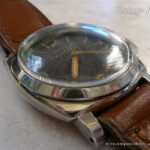 Aguttes will auction a Ref. 6152/1 “Luminor Panerai” with unique caseback engraving dedicated in the year 1983 to Admiral Cataldo Gigantesco.
Aguttes will auction a Ref. 6152/1 “Luminor Panerai” with unique caseback engraving dedicated in the year 1983 to Admiral Cataldo Gigantesco.
We know this watch since June 2007 during a Panerai collectors meeting in Tuscany, where it submerged soon after for years and now surfaced for sale online at Aguttes (France). It is part of our database since Marco, son of the Admiral, showed us the watch 16 years ago (see photo on the left).
You can find more info on this rare Ref. 6152/1 with Rolex Cal. 618 / Type 4 movement and the unique engraving on its caseback at our Watch Point.
Training scene in the summer of 1944
by Volker on May.26, 2023, under Allgemein
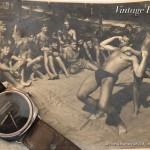 A few days ago we received an interesting photo from the grandson of a German “Kampfschwimmer”. With his support we were able to add the Ref. 3646 / Type B “Radiomir Panerai” into our database last year – read more here.
A few days ago we received an interesting photo from the grandson of a German “Kampfschwimmer”. With his support we were able to add the Ref. 3646 / Type B “Radiomir Panerai” into our database last year – read more here.
Actually, the photo is not new to us. It has been published many years ago in Cajus Bekker’s book “Einzelkämpfer auf See” in 1968 and again in 1978. However, there were never published names of the frogmen in the captions of these two books. Until now: The backside of the original paper photo showed pencil written names of the men which were captured in the photo, which helped us now to identify and link them to other photos in our archives. We have published a photo, taken from a slightly different perspective, showing the same training scene, in chapter V of our book “History2” on page 460.
The photos were taken in the summer of 1944 on the island of San Giorgio (south-west of Venice harbour), showing the training in hand-to-hand combat, which was a fixed part of their training along with other different sporting disciplines. One of the frogmen in the photo is the first owner of the Ref. 3646 / Type B watch on the left.
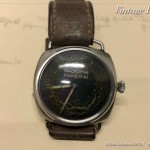 Read more on the activities on the island of San Giorgio in chapter I of our book “History1” including rare historic documents and aerial photographs from the Allied Forces intelligence.
Read more on the activities on the island of San Giorgio in chapter I of our book “History1” including rare historic documents and aerial photographs from the Allied Forces intelligence.
Our special thanks to the frogman’s grandson who provided the photo above (including the additional informations on ist backside in shape of handwritten names), on which he placed the Ref. 3646 / Type B “Radiomir Panerai” of his grandfather. [Ralf Ehlers & Volker Wiegmann]
Our database – an interim status on 1 January 2023
by Volker on Jan.25, 2023, under Allgemein
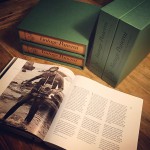 What happened after 1 January 2016 when we “paused” counting new entries in our database for a moment to complete our book set “The References”? We continued to count and still do that – since 2003 (…20 years ago). January 2023 was a good time to pause again and see how our records have changed in numbers of known watches in our database. The total number of all historic Panerai watches in our database from the 1930’s to the 1960’s has grown to 449 known watches.
What happened after 1 January 2016 when we “paused” counting new entries in our database for a moment to complete our book set “The References”? We continued to count and still do that – since 2003 (…20 years ago). January 2023 was a good time to pause again and see how our records have changed in numbers of known watches in our database. The total number of all historic Panerai watches in our database from the 1930’s to the 1960’s has grown to 449 known watches.
Back in 2016 we had 211 entries of the Reference 3646 in our database (seven different number groups, from 3646 / Type A to 3646 / Type G). Since then, 53 watches of the References 3646 have been added into our records, making a total of 264 watches of the reference 3646 today. Find an interim status on 1 January 2023 below:
Reference 2533: 3 examples known (2016: 3)
Reference 3646 / Type A: 18 classified (2016: 18)
Reference 3646 / Type B: 21 classified (2016: 16)
Reference 3646 / Type C: 65 classified (2016: 52)
Reference 3646 / Type D: 107 classified (2016: 79)
Reference 3646 / Type E: 32 classified (2016: 26)
Reference 3646 / Type F: 11 classified (2016: 11)
Reference 3646 / Type G: 10 classified (2016: 9)
Mare Nostrum Chronograph: 1 example known (2016: 1)
The watches made by Guido Panerai & Figlio after the Second World War, those with solid lugs, references 6152, 6154, 6152/1 and GPF 2/56 as well as the transitional references and those with Angelus movements increased from 162 to 181. Most additions are watches of the reference 6152/1 – all four versions (Rolex and Angelus movements, Rolex crown and Panerai crown guard) increased from 103 (2016) to 117 specimen classified in our database on 1 January 2023.
Reference 6152 / Type A: 7 classified (2016: 7)
Reference 6152 / Type B: 2 classified (2016: 2)
Reference 6154: 18 classified (2016: 15)
Reference 6152/1 Rolex with Rolex crown: 24 classified (2016: 23)
Reference 6152/1 Rolex with Panerai crown guard: 73 classified (2016: 64)
GPF 2/56 Angelus: 27 classified (2016: 25)
Reference 3646 Angelus: 5 classified (2016: 5)
Reference 3646 Transitional: 5 classified (2016: 5)
Reference 6152/1 Angelus with Rolex crown: 8 classified (2016: 6)
Reference 6152/1 Angelus with Panerai crown guard: 12 classified (2016: 10)
At this point, again, we want to thank those who shared information on the watches lined up above with us. Auctioneers, collectors, veterans or their family members and friends.
Ralf Ehlers & Volker Wiegmann
New entry in our database: an engraved 3646 / Type D
by Volker on Jul.17, 2022, under Allgemein
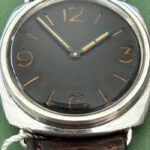 We added another previously unknown watch into our database – yet another piece of the puzzle surfaced, which marks the first entry of a Ref. 3646 / Type D in 2022 and in total the Type D #107 in our records.
We added another previously unknown watch into our database – yet another piece of the puzzle surfaced, which marks the first entry of a Ref. 3646 / Type D in 2022 and in total the Type D #107 in our records.
The “Kampfschwimmer” watch with anonymous sandwich dial appears with a rare engraving on its caseback, bearing the initials of the first owner and the name of the unit he belonged to (Marine Kampfschwimmer 1945).
The inner caseback of the watch (full polished, read more in “The References” 1930’s-1940’s on page 486-487) bears the Rolex SA hallmark, reference and case number known for 3646 / Type D watches. Inside the watch is a Rolex Cal. 618 / Type 1 movement with typical decorations and engravings on the bridges (ROLEX 17 RUBIS / FAB. SUISSE).
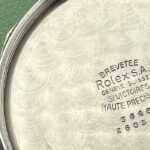 Still sewn onto the soldered lugs is the original leather strap (!) including the large and very rare nickel-plated brass pin buckle. The watch has its original onion shaped winding crown and the typical blued steel hands with original luminous material.
Still sewn onto the soldered lugs is the original leather strap (!) including the large and very rare nickel-plated brass pin buckle. The watch has its original onion shaped winding crown and the typical blued steel hands with original luminous material.
Features of the watch:
Reference: 3646 / Type D
Dial: “Kampfschwimmer” (sandwich, anonymous)
Case number: 2605XX
Movement: Rolex Cal. 618 / Type 1
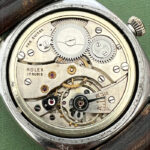 The first owner of the watch took part in a frogmen mission against Russian pontoon bridges across the river Oder at Aurith, near Fürstenberg, in March 1945. You can read about these frogmen missions in our book “History1” in chapter II on page 83-123. The first owner was born in 1924 and passed away in 2000.
The first owner of the watch took part in a frogmen mission against Russian pontoon bridges across the river Oder at Aurith, near Fürstenberg, in March 1945. You can read about these frogmen missions in our book “History1” in chapter II on page 83-123. The first owner was born in 1924 and passed away in 2000.
The watch is accompanied with an interesting documentation of his service during the Second World War and further information about his life, after he was released from British imprisonment in 1945.
If you are interested to buy this watch, please contact the owner directly via e-mail: albert59er@t-online.de
Ref. 3646 / Type C “Radiomir Panerai” @ Dr. Crott
by Volker on Apr.15, 2022, under Allgemein
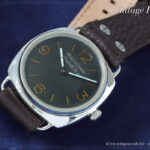 We recently added another unknown watch into our database – yet another piece of the puzzle surfaced: a Ref. 3646 / Type C with “Radiomir Panerai” sandwich dial, being watch #63 in our records of watches matching the criteria of the 3646 / Type C.
We recently added another unknown watch into our database – yet another piece of the puzzle surfaced: a Ref. 3646 / Type C with “Radiomir Panerai” sandwich dial, being watch #63 in our records of watches matching the criteria of the 3646 / Type C.
The Ref. 3646 / Type C “Radiomir Panerai” will be auctioned on 21 May 2022 at Dr. Crott’s 106th auction in Mannheim/Germany. It has been consigned by the family of the German “Kampfschwimmer” veteran Heinz Greten. Further info on auction lot 156 can be found here.
The watch appears with an unpolished case with a matching high bezel, typical for watches with “Radiomir Panerai” sandwich dial. The watch comes with a tubular shaped Rolex Oyster crown (Type 13). Inside the watch is a Rolex Cal. 618 / Type 1 movement with typical decorations and engravings on the bridges (ROLEX 17 RUBIS / FAB. SUISSE). The inner caseback bears the typical Rolex SA hallmark, reference and case number known for 3646 / Type C watches, with “Half Polish” decoration. Both hands appear black painted and re-lumed. The inner caseback bear also watchmakers’ service marks.
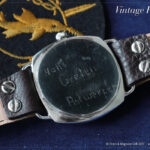 Noteworthy:
Noteworthy:
The outer caseback of the watch bear engravings of the first owner, German “Kampfschwimmer” Petty Officer Hans Greten with the additional info Antwerpen, referring to a mission he took part in September 1944.
The mission (“Operation Bruno” – the attack of the Kruisschans floodgates in Antwerp) is documented in the book “Sabotage unter Wasser” written by Michael Jung (2004) on page 120-121, as well as a photo of Hans Greten on page 107. Further info on this frogmen mission is also found in the book “Das Kommando der Kleinkampfverbände der Kriegsmarine” written by Helmut Blocksdorf (2003), on page 181. The earliest documentation of the mission is dating back to 1956 in the book “…denn sie liebten doch das Leben” written by Cajus Bekker (chapter six, page 148-160), in which Greten is mentioned several times (all books are written in German language).
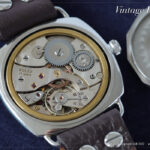 Features of the watch:
Features of the watch:
Reference: 3646 / Type C
Dial: “Radiomir Panerai” (sandwich)
Case number: 10102XX
Movement: Rolex Cal. 618 / Type 1
In our book “The References” 1930’s-1940’s the watches of the entire reference 3646 are featured in chapter II with more than six hundred pages in the chapters II.I-II.VII. The seven different variations (including the number group 3646 / Type C – page 248-397 – to which this watch belongs) can be found in our reference quickfinder on page 14-20.
Please note that the very rare campaign insignia 3rd degree (visible in the background of the second photo) is the (separate) lot 155 and is not included in the lot of the watch. Information on different probation and campaign insignia of the German “Kampfschwimmer” units can be found in our book “History2” in chapter IX.
We hope the watch will find a good new home and that it remain surfaced in the Vintage Panerai collectors world. [Ralf Ehlers & Volker Wiegmann]

